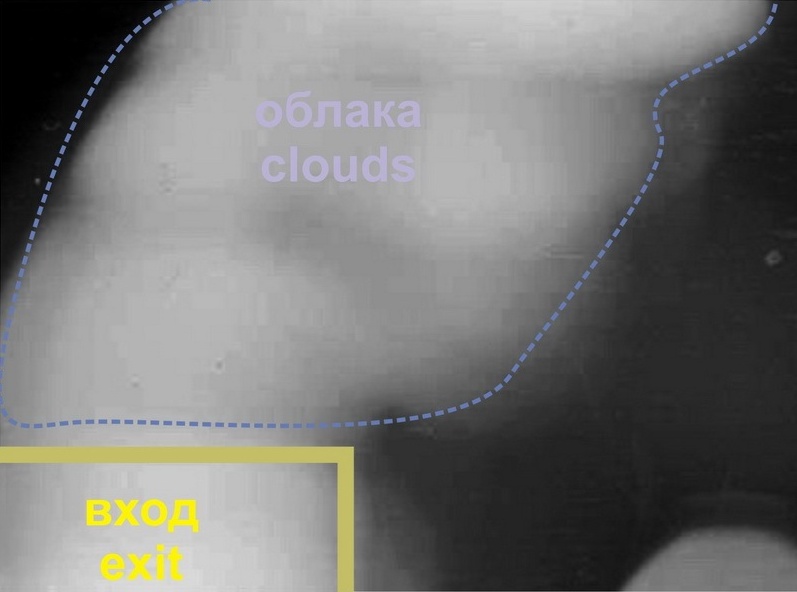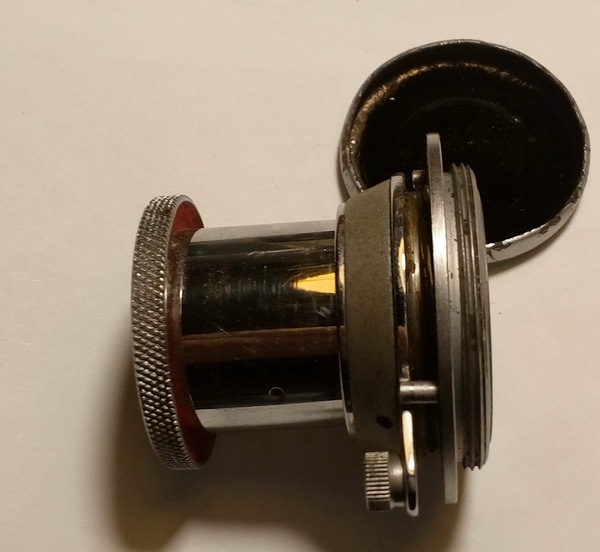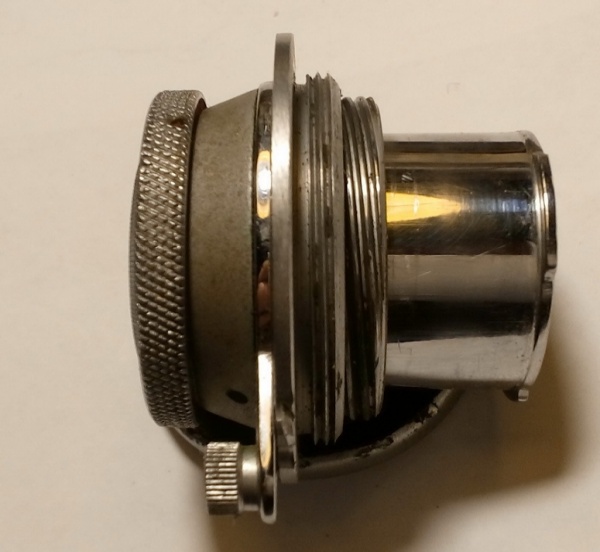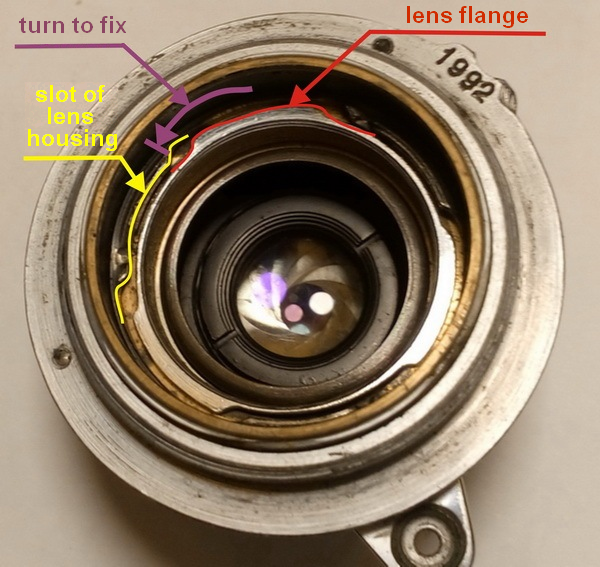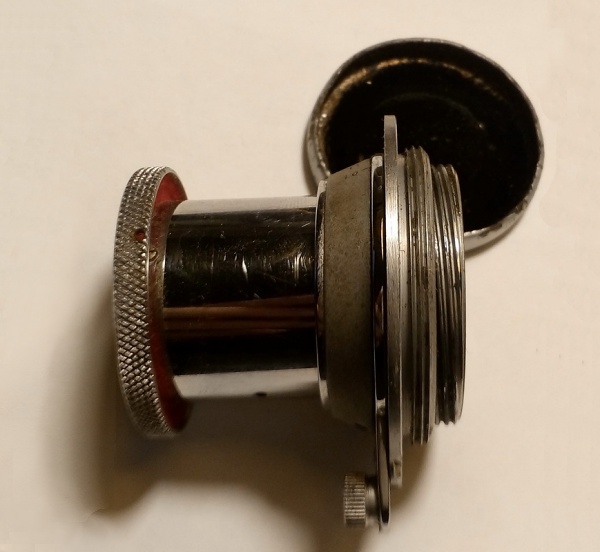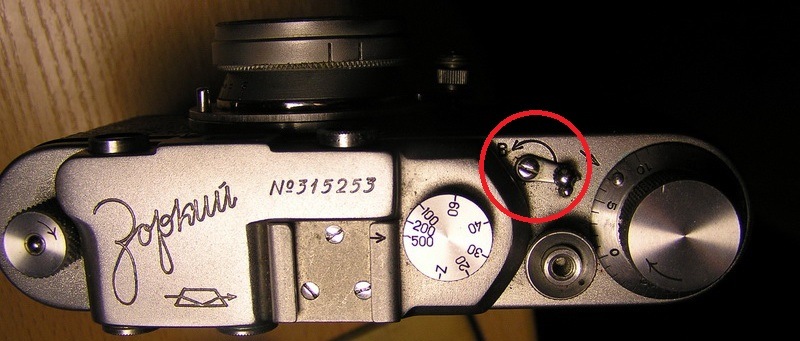
Vladimir Borzenkov analysis of frame 34 from Krivonischenko film 1
The last shot of Georgiy Krivonischenko's camera became very popular.
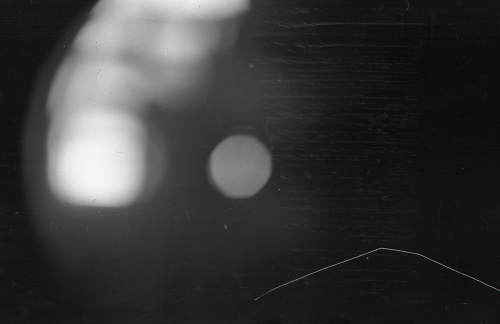
Here is a link to the original scan.

The negative of frame 34
If conspiracy ambassadors have this immense "fantasy allowance" on the topic to think up something unreal, based on the lack of real facts, then why can't we present something real if there are real facts available for it?
I believe that there is nothing mysterious in this frame. All mystery lives only in the minds of conspiracy theorists.
It should be noted that most qualified amateur and professional photographers basically share a point of view similar to mine. The fact that there is nothing unusual in it and that the shot is "technical" and made entirely by accident.
If you look at this image from the point of view of a qualified photographer who dealt with chemical photography (shooting on a photosensitive film and developing it in photo chemicals), then nothing special can be found in it.

Distinguishable objects (areas) of the image
Main and significant
- A rectangular light spot (this is all said for a positive image) in the middle of the left side,
- 8 faced polyhedron (octahedron) in the center of the frame,
- Whitish wide blurred strip from the rectangle up and to the right.
Secondary
- Thin strip in bend shape
- From the center of the frame to the right there are rows of surface scratches, the cause of which is contact with the metal surfaces of the transport unit of the camera film (flat pressing surface of the back cover of the camera), as well as mechanical defects from careless handling of the film. Weak longitudinal bands are the result of multiple folding and or dragging of the film along the glass of the photo enlarger), or something like that.
- An area of whitish exposition, not as intense in brightness as object No. 3 (the brightest area in the image) and "covering" almost half of the frame, where the main analyzed objects are located. It can easily be removed by means of image processing (for example, increasing the contrast), which was done on most of the images published on the web.
Concerning the exposure of the image, it can be said that it was produced without focusing on the sharpness, from a dark room to a light object, for example, an open tent canopy. The white octahedron in the center of the frame is an optical effect. Errors in focusing can occur due to the following:
- this was neglected,
- range finder was defective,
- or when the viewfinder fogs up.
Exposure was quite permissible, that is called "by hand". This follows from the fact that there is almost nothing "smeared". In any case, this is not visible. At exposure times of the shutter greater than ¼, ½ sec, this usually does not work. By the way, such excerpts and there is not on that camera ("Zorki" №486963), which was used to filmed this frame.
Surely the camera settings before this "last shot" were installed in relation to the illumination, the two penultimate frames. When the group goes in conditions of poor visibility already in the woodland. And the shutter speed, aperture, and the focusing distance to the sharpness (depth of field), most likely, did not change.
- 2 -
If you start to analyze all these objects, you can get the following explanations:
Object №2
It's easiest to explain the presence of the octahedron (object №2). This effect often appears when a thin beam of light enters the lens in such a way that it does not fall directly into the photographic material field, but is reflected from the side surfaces of the objective lens to form an image of the diaphragm's petals. When shooting against the light due to internal reflections in the lens, a parasitic light may appear on the pictures - in the form of glare. Such a glare comes from a bright source, for example, the sun, a light bulb in a room or a lamppost, etc. The source itself does not have to be in the frame.
Virtually all lenses, except the simplest, consist of several "optical elements". This is the lenses themselves and assemblies of several lenses. Glare initiates a light that is outside the limits of the image on the frame. This light, instead of passing through the normal optical path, is reflected from the optical elements inside (an arbitrary number of times) before it reaches the film.
Modern optical elements usually have different anti-reflective coatings that are designed to eliminate glare, but no multi-lens can not completely eliminate them. The rays from the light sources will still be reflected inside and this reflected light will be in the frame in the form of highlights in areas where it will be comparable in intensity with the light of the main image. Glare in the form of polygons are caused by light, which is reflected from the inner surfaces of the lens.
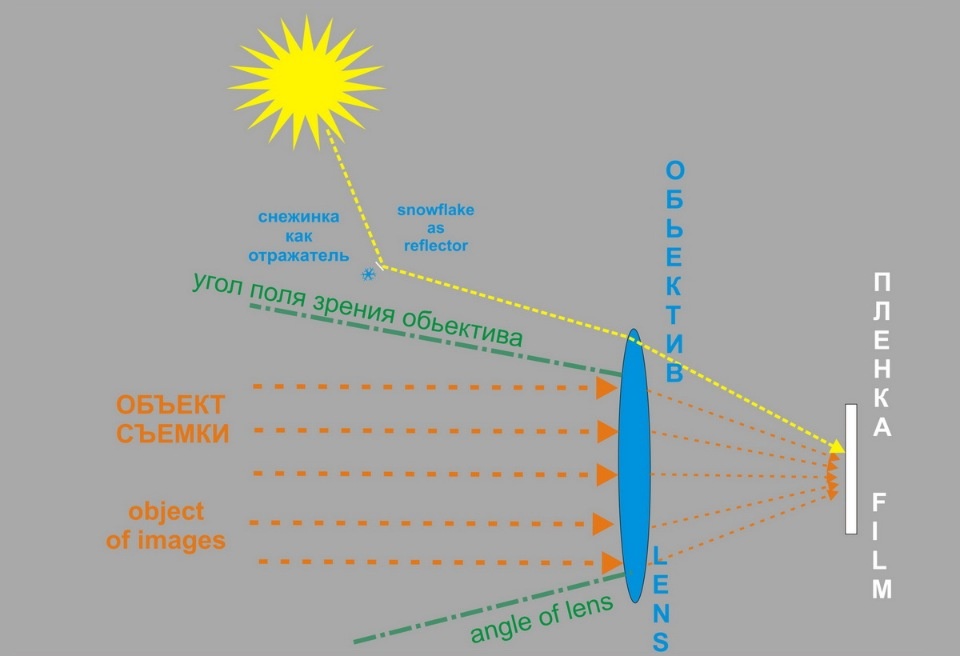
Formation of "false" images on film
That there might be reflections caused by internal re-reflections, it is necessary to have external high-brightness lighting sources. Such sources can be the sun, artificial lighting. Such "random light" can get into the lens if it hits the front lens of the lens. Usually, the light outside the angle of the lens does not affect the resulting image, but if this light is reflected from the inner parts of the lens, it can go through an unintended path and get on the film.
If we say "in general", then it should be noted that in modern lenses, effective anti-glare coatings are usually used. Some old lenses, for example, Leica, Hasselblad, Zeiss, FED until 1948, and all Soviet (and most foreign) cameras that were produced at an earlier time do not have any special coatings, and therefore can highlight very much even with a soft light.
Sometimes this technique (a specially generated occurrence of highlights) is used by photographers to obtain a special artistic effect, or to "liven up" a photograph.
The octahedron is a reflection of the shape of the diaphragm of this lens. This is a common phenomenon when shooting against the sun or another bright light source. For this effect, you need a narrow bright beam that enters the lens. This was not a problem at the site of the search camp in 1959. The sun was just from the entrance to the tent, and it was very simple to find a flat snowflake "at a very obtuse angle", like a "mirrored dot".
Such effects are not uncommon. Here is one example from my own practice. This picture was taken with "Praktica LTL3" by "Pentacon Dresden" (GDR).
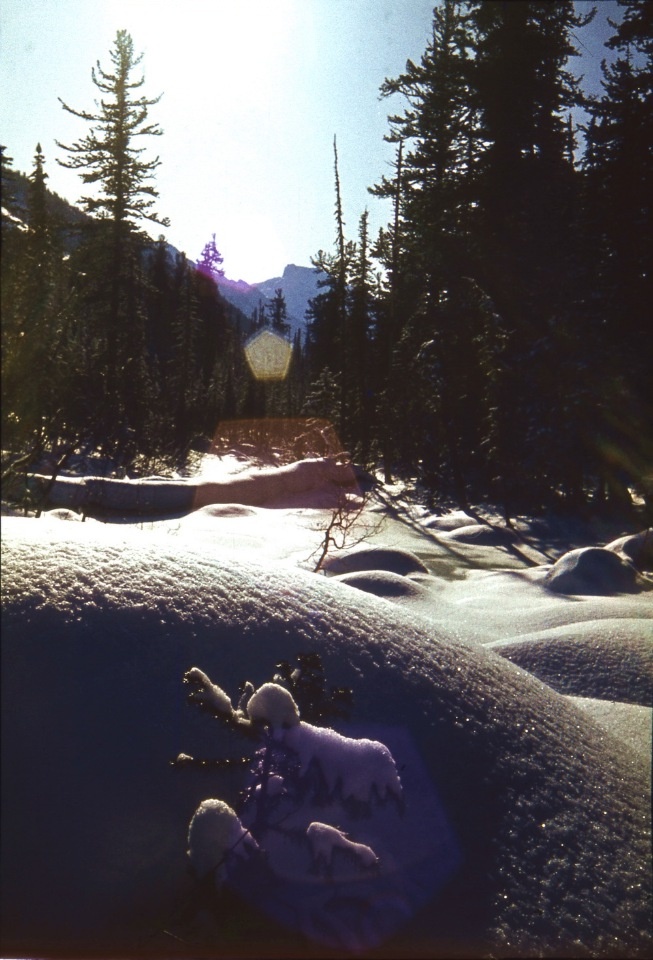
Illustration for diaphragm imaging
This picture also clearly shows the pentagon of the diaphragm of the Zeiss lens «Pancolar – 1,8/50».
In the example above, the sun practically did not hit the frame, but nevertheless caused pentagon glare.
On the exemplary frame there are a few pentagons (in contrast to the frame from Krivonischenko's film), but the Zeiss lens is more complex, and has several groups of lenses. In addition, he more sharply "draws" the image. Therefore, you can see even the weakest parts of the highlights. What contributes to more and more perfect (and also colored) Film of a later period.
In my photo the appearance of the "polygon" in the frame is not accidental, I tried to achieve this artistic effect when I was shooting.
- 3 -
The photo from Dyatlov group was made through another, simpler lens - Industar-22, which has an octahedron diaphragm. This is what I have on the pictures of my study - same lens, even about the same years of release, «Industar-22» with aperture 1:8 is shown on the picture below.
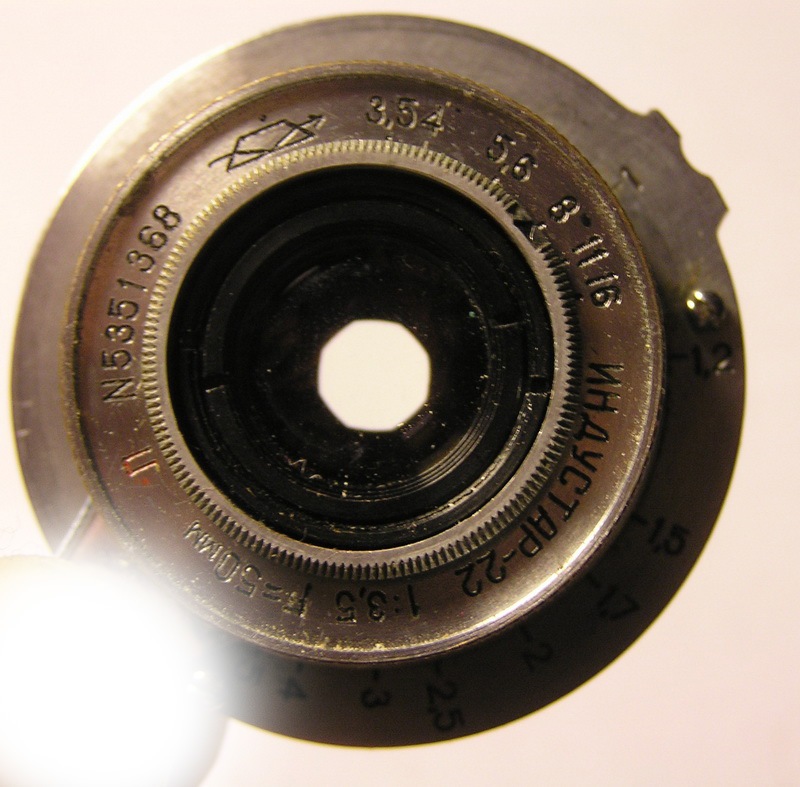
The shape of the diaphragm of the lens «Industar-22»
What can you find about this lens in the literature?
"It gives a very specific glare - a sharply outlined image of the diaphragm. This is due to the fact that it has flat surfaces on the front lens and on the last component (or close to flat ones, it is difficult to obtain a technologically difficult plane, so it is made weakly convex). Thus, the scattered light does not spread throughout the image field but concentrates in These reflections diminish the scattered light and improve tonal transmission on exactly two enlightened surfaces - as if there are gluing, which is characteristic." Prof. D.S. Volosov, Photographic Optics, 2nd ed., Moscow:" «Art», 1978.
Well-defined facets have a glare as in the above picture, they can also be seen in the "last" photo of Dyatlov group. Despite the blurred image.
From all that has been said, we can state that when shooting, there was a thin, non-divergent, bright beam of light. This could only be: a ray of sun - in nature, or artificial - a laser beam. And obviously not red color, because all the films used in 1959 had a sensitivity dip in the "red" range.
Hoping for a green laser in 1959 would be too presumptuous. Actually as a laser in general, in the same place, in that period.
There is also a completely reliable explanation of where this ray could come from. There is an assumption that this picture was taken in the tent of the search group after the camera G. Krivonischenko was brought there. This has already been clarified among the participants of the searches (I specified this in V.G. Karelin and P.I. Bartolomey). The tent of their group in the region of Auspiya stood on the clearing by the entrance almost exactly to the south. Therefore, in sunny weather, a thin ray from the sun could easily appear, which reflected from one of the numerous ice crystals (frost) formed at low negative temperatures. In the winter of 2014 and 2015, I myself have seen many such "microchips" of ice crystals many times in the same place where the search group's tent stood in 1959.
Object №1
Object №1 (from the list), is a rectangle very close to a square.
Therefore, its original original form and image in principle can not have a different form. In optics, there is a clear pattern in the distortion of the shape with a loss of focus - a square object, due to the loss of image clarity, can approach the shape of the circle. But it's never the other way around. Therefore, we can safely assume that the original object is rectangular. And having a great brightness.
A bright spot is perceived as a source of bright light, much higher intensity, relative to the surrounding room. And if you compare with the environment - at least more than an order of magnitude greater than any object on the frame near and more than the "exposure latitude" * of films of that period. The room itself, where the picture was taken, is quite dark. In any case, strongly obscured, relative to the external light background. This object was filmed, not specifically, that is, it was not exactly shot.
From all that has been said, we can confidently assume that the «square» in the frame is the entrance to the tent that was opened. Below it will be told where it could be with the greatest degree of probability. And what could be this object.
* "exposure latitude" - the extent to which a light-sensitive material can be overexposed or underexposed and still achieve an acceptable result. This measure is used for digital and analogue processes, i.e. optical microlithography or photography.
Object №3
The second, lighter than the background, but the "translucent" outline refers to «object №3». Let's take a fragment of this image:
It most of all resembles a translucent gaseous medium, such as steam, finely dispersed suspension or something similar. It seems that this "something" rises upwards, since it is lighter than air in the room, and with a brightly bright light from the area "Object №1", indicated in this picture as "exit".
- 4 -
Most of all, this resembles a cloud of steam (as indicated in the diagram above), formed from the cold air from the street into the tent of the rescuers, in which the stove was heated. It is moisture condensing in cold air with back light. Such a trace is obtained by condensing water vapor inside a warm tent, when outside cold air, illuminated by the bright external light of a sunny day, bursts into the door. This state is very typical for this kind of state of the tent. This was constantly observed in practice under similar conditions. There is always an excess of moisture from constantly drying clothes, and a couple, from cooking and eating food in the cold. The necessary physical conditions for this are:
- great difference in air temperatures outside and inside
- the presence of a humidity level near the condensation point
- excess of such moist air
- open entrance (draft)
- back light
All these conditions are completely characteristic for conditions of the type that were in the tent of the search group in 1959.
It is unlikely, but it is still possible that this train can be considered a reflection of light on the canopy of the wall of the tent. But then there must be a large reflecting surface next to the entrance. Although there is nothing surprising in the fact that there was a lot of snow around.
A few words about the general blur of the image….
Notable for this photo is also the fact that all the details of the image on it are outside the depth of field of the lens.
The last shot, judging by the complete lack of focus throughout the frame, was made on condition that the operator did not have time (or did not intend) to extend the lens barrel to the end when photographing. Most likely, I did not have time to change the exposition.
When the tube is not fully extended, the projection image is not on the plane of the film (as in the "normal mode"), but on the plane located behind the film. Therefore, a blurred image is obtained, and with a completely non-extended lens tube, a circle is obtained.
On the two pictures below this is clearly visible.
The case of a completely non-extended lens is excluded, because it would produce the following image:
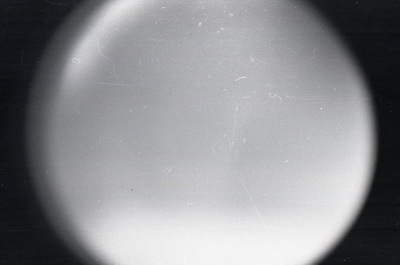
The image obtained with a completely non-extended lens of «Industar-22»
In Dyatlov group films there is such a frame. SKAN_6_002.jpg – scan from film №6 (this is the numbering in the initial scan).
«Industar-22» has the same optical system as its prototype «Tessar» from 1902.
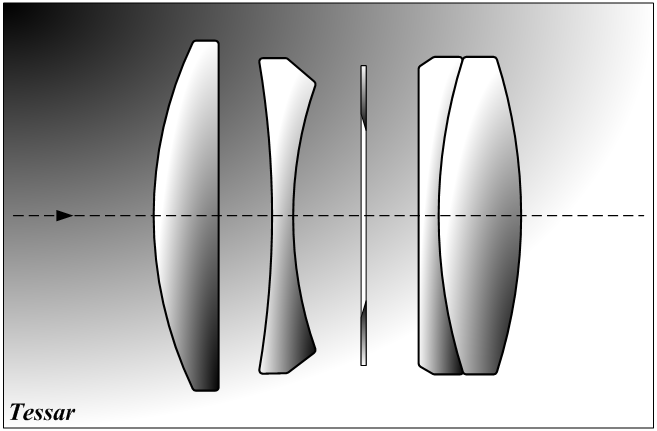
Optical scheme of lenses «Industar-22» is same as «Tessar»
ru.wikipedia.org/wiki/Индустар
camera-wiki.org/wiki/Industar-22
Lens mount
ru.wikipedia.org/wiki/Байонет_объектива
en.wikipedia.org/wiki/Lens_mount
In order to take a picture, the lens should be pushed from the inside to the stop and fixed on the bayonet lens mount. Bayonet lens mount - this is the type of fixation when required, push it forward and insert it into the grooves, turning it all the way to the small angle. As will be shown in the pictures below.
- 5 -
It may very well be that the lens was pushed out, but not completely (for example, it was not put on the bayonet lock, that is, it did not reach the end of the installation of the working segment.) It's very easy not to get into the bayonet's grooves (I specially tested it on the same camera "Zorki").
ru.wikipedia.org/wiki/Рабочий_отрезок
en.wikipedia.org/wiki/Flange_focal_distance
The scheme of operation of the bayonet lock of the lens «Industar-22» (4 photos below) shows the mechanism for fixing the telescopic lens tube.
The mutual position of the flange projection and the slot of the lens body «Industar-22». The sequence of actions when fixing the retractable tube of the «Industar-22» lens. In the three pictures below, different variants of the position of the bayonet lock are shown.
It is necessary to pay attention to the correspondence between the mutual position of the lens flange and the groove of its housing.
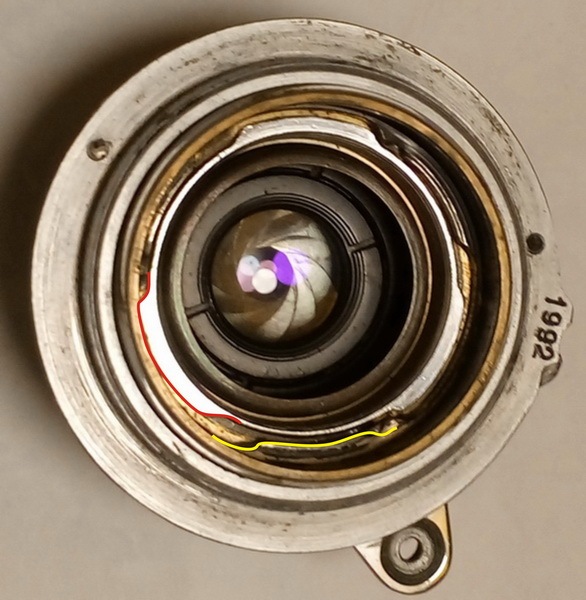
The lens is extended but the bayonet lock is not closed (the flange is not in the slots of the lens housing)

The lens is extended and the bayonet lock is closed (the flange is pushed into the slots of the lens housing)

The lens is pushed out but the bayonet lock is not closed (the flange is on top of the lens housing slots)
The difference in the installation on the bayonet in the normal and "unattended" state (the lens is pushed out, but not in the grooves, but remained behind i.e. higher - closer to the film, the bayonet lock) = 1.3 mm
The flange focal distance is the distance from the mounting flange (the metal ring on the camera and the rear of the lens) to the film plane. In «Industar-22» this is 28.8 mm
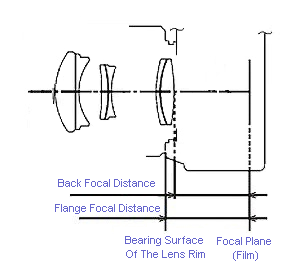
and the full focus from mark "1 м" to mark "infinity – оо" is 2.5 мм
i.e. "non-advancement" with incorrect installation of the bayonet lock is equal to more than half of the entire focus scale, which means that even if the distance scale of this lens was set to "infinity", in fact, the setting was approximately "2 m"
- 6 -
And it is possible that (in addition, or even simply without it), the distance mark was set to "minimum", for example, to "1 m". And to the main objects of shooting was a greater distance.
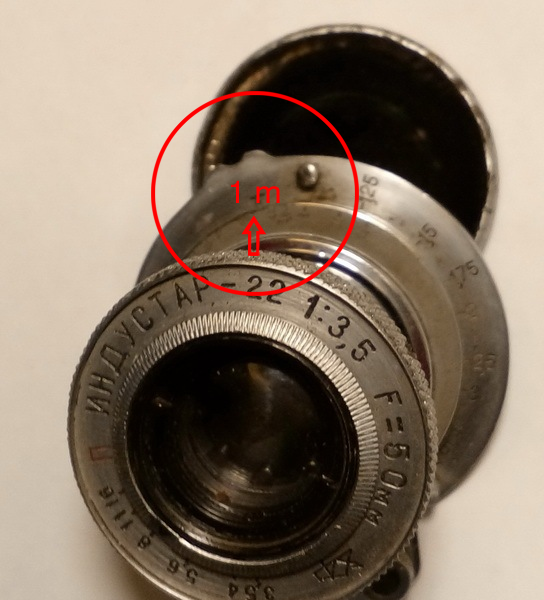
The pointer of the distance scale is set to 1 m
All this suggests that the defocusing was large enough, but not so that the lens would not be fully extended. In that case, the distance to the film would be about 9-11 mm, which is 6.8 ... 7.6 times the full-scale of the focus, which would give the image of the "ring".
Hence, one can conclude that even when the aperture is closed to 8 ... 11, the depth of the Sharply Imaginary Space (FLIP) can be very small when setting the sharpness to around 1 m, ie, the extreme left position (corresponding to the maximally extended position). Or, which is the same thing - not fully put forward (not put on bayonet fixation). The lens is of the same type as «Industar-22».
More accurate data can be obtained if we calculate the Depth-of-Field for the «Industar-22» lens and the apertures at the level 1: 5,6 ... 1: 8 (and near this range). DOF tables for the «Industar-22» lens for the entire range of apertures and basic points of focusing are shown below.

Depth-of-Field for lenses with focal length = 50 mm (for example, «Industar-22») for apertures from 1:2 to 1:6,3
The frame marks the intervals from the minimum distance to "infinity" for each aperture value
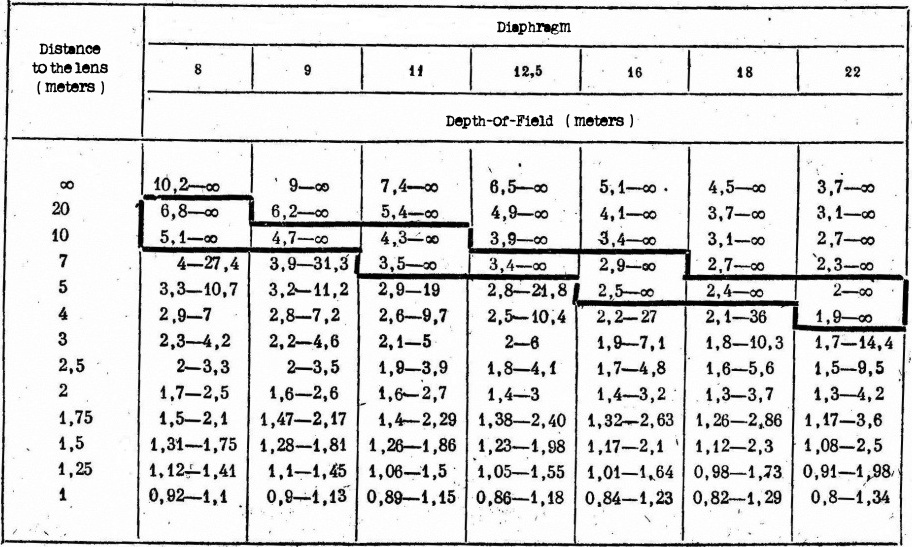
Depth-of-Field for lenses with a focal length = 50 mm (for example, «Industar-22») for apertures from 1:8 to 1:22
The term "diaphragm" is equivalent to the concept of "relative lens opening", i.e. the ratio of the current light diameter of the diaphragm to the focal length of the lens.
ru.wikipedia.org/wiki/Диафрагма_объектива
en.wikipedia.org/wiki/Diaphragm_(optics)
All modern cameras have a so-called "iris diaphragm".
Object №4
A thin strip in the form of a bend, reminiscent of the "hill" of Holatchahl, like the conspirologists like to call it, is a hair attached during storage. It is an accidental artifact that appeared on film for many years of its movements, inspections and repackaging, which is stored in the archive of the Memorial Fund of the Dyatlov group, it is no longer there, he just stuck in the period before scanning, and then fell off.
Object №5
The rest of the film available on the modern frame is the defects of the film when it is used and stored. The film was stored rolled up, then there is an increased danger of getting these scratches. As far as I know, having been engaged in photography for more than 50 years (most of which are chemical photography), these are scratches when the film is twisted and stored. Complicated by the appearance of microscopic crystals of chemical substances from time and temperature from dried photographic solutions (the smallest sharp objects, completely damaged the emulsion), which processed the film. Well, maybe there is dust as an additional "formative". These are so common defects that few of the qualified photographers pay attention to them on the 10th (not to mention the 50th) year of storage of films. Moreover, these films were not stored "in science" - cut into six frames and placed in a sink, but simply rolled up and wrapped in paper ...
Object №6
This is a region of whitish exposition, in brightness less than object No. 3 and "covering" almost a half-frame - as noted above. This is a manifestation of the fact that the lens of the lens dropped condensate when introduced from the frost into heat. Even if the lens was rubbed, traces of this condensate still had to remain. They gave this effect. And as it was mentioned above, on most of the images on the Internet, it was removed by means of electronic image processing (again, for example, increasing the contrast), considering it irrelevant to what was actually the case.
- 7 -
I. When was this frame shot
- The shot was probably made by chance, and after all the events on 01-02.II.1959. It is clear that it was made after Dyatlov group passed the Boot Rock, 1 km before the last place they pitched their tent. +/- 100 ... 200 m from this stone. This is indicated by 2 previous pictures.

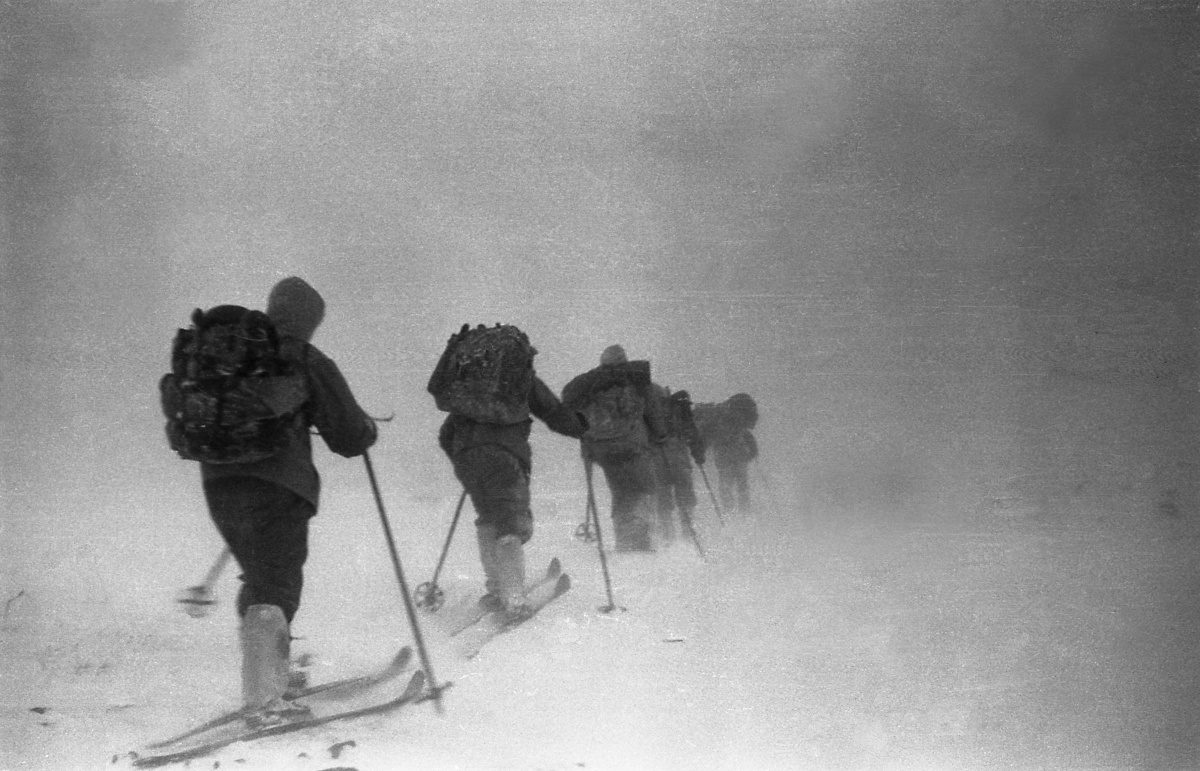
- Most likely the shot is taken in the tent of rescuers between 26 ... February 27 (when the camera was brought to the searchers camp) and the day when it was sent to Ivdel with someone from the investigators, for example, L. N. Ivanov or V. I. Tempalov. It is necessary to find out when there was good sunny weather at this time, and it was quite cold. Although these two states are compatible and completely natural for the winter conditions of February-March 1959.
But the cut-off time i.e. when it could no longer be made, is very vague: it can be any time before the development of the film begins. Even more precisely, before the film was rewound back, onto the feeding cassette. And this could be in the searchers camp in the interval from February 26 ... 27 until March, when investigators took off with the evidence.
- The next place where the camera could have been handled and there could be conditions for shooting such a frame is a small building on Ivdel airfield, where all things were brought and sorted, or other manipulations took place. After that, the film must have been developed. And after that, in urban conditions, it was very difficult to find a set of similar conditions.
- The least likely it was in the morgue where the autopsy was done. Why did I bring the last possible place? Yes, because there is a film from the archive of L. N. Ivanov, where only the bodies in the morgue have been removed, and there is the very first frame that looks like this:
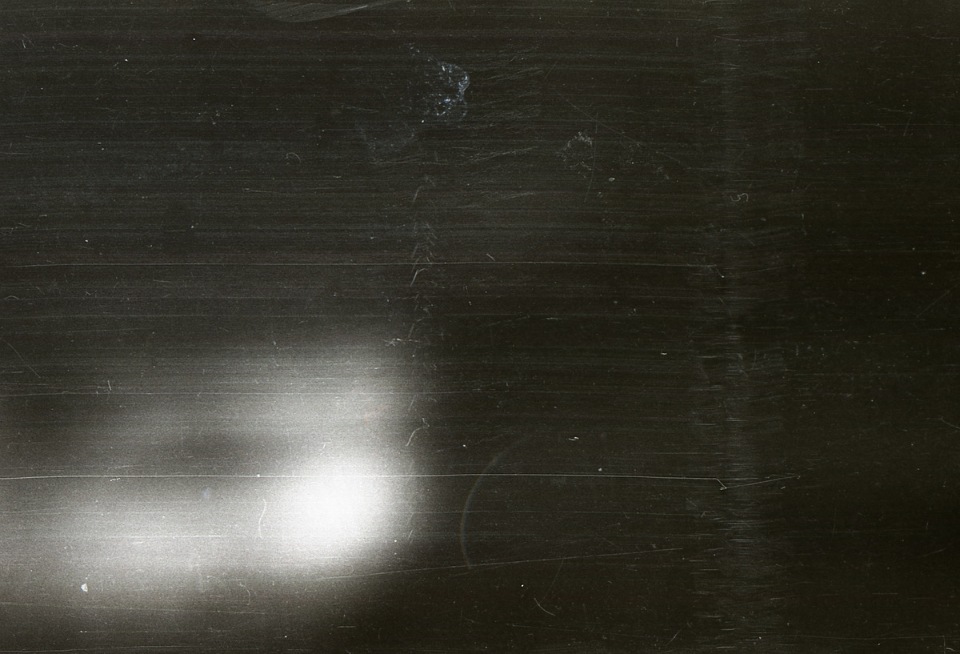
The very first picture on the film of the investigation, filmed in the morgue of the city of Ivdel, when there were bodies of the first four (five) in early March 1959This first frame on the film photographers who provided the investigation (where all the pictures are taken exclusively in the morgue), is very similar to that last one. By the general style, layout, shooting conditions and, most importantly, by a square bright silhouette, which very much resembles a window. Such a combination in marching conditions is almost impossible to obtain. The fact that he is technical is clear on all the criteria of photography: the very first, very close to the charging end, is shot at random, i.e. not caring about anything, etc.This film has nothing to do with Dyatlov group cameras, it was shot after the bodies were taken to the morgue. However, on this very first frame from this film there is an image that is somewhat reminiscent of what is on the "last frame" from G. Krivonischenko's film. Apparently the shooting conditions were very similar. In terms of the ratio of the darkness of the room and a bright fragment of a similar shape.There is no overlap between the two photos, of course, but one can find similarities. Once again I want to note: On this film there is nothing else but the corpses of the deceased in the morgue.But all artifacts (a bright spot, not quite a round shape, an object in the form of a cloud of translucent consistency) are present. In any case, it has something similar ...Most likely, an out of focus window gleams light on the walls in the dark room of the morgue. And the frame is also "technical", i.e. made only to ensure that the film is guaranteed to be held in the camera further than the exposed charging end. This is what photographers usually do. Some people do this with a lid on the lens (but then there won't be any image at all), and some do it without a lid on the lens and then all that is captured in the shot is by chance, like in the photo above.
- 8 -
II. Where was the photo taken
"The scenery" in the photograph in question can be explained by the fact that it was shot in a room limited in size, in which there were no uniformly colored light surfaces, and some darker objects were closely located, behind a dense surface, not an open space.
- The most likely place can be a tent of a search group in their camp on the river Auspiya. The next photo shows the part of the door of the tent
We can point to a number of key coincidences that can add to this assumption. The entrance to the tent was set (direction of shooting, as well as the direction of the solar exposition) - almost strictly to the south, that's exactly the tent of rescuers in the clearing. This information I received from V. G. Karelin back in February 2009. And then everything coincided when I reconnaissance the location of this camp on the spot. The fact that this is the meadow is not to be doubted. On it, we found a large number of flat-cell batteries for a tube radio station, in August 2009. And the orientation of the tent can also be just to the south, because in a different position, it will be quite inconvenient to place. There they go, so differently, either the people will roll down one of the parties, or sleep "upside down", which again, it's completely inconvenient. This same position gives the opportunity to catch a direct ray of the sun, with the appropriate weather.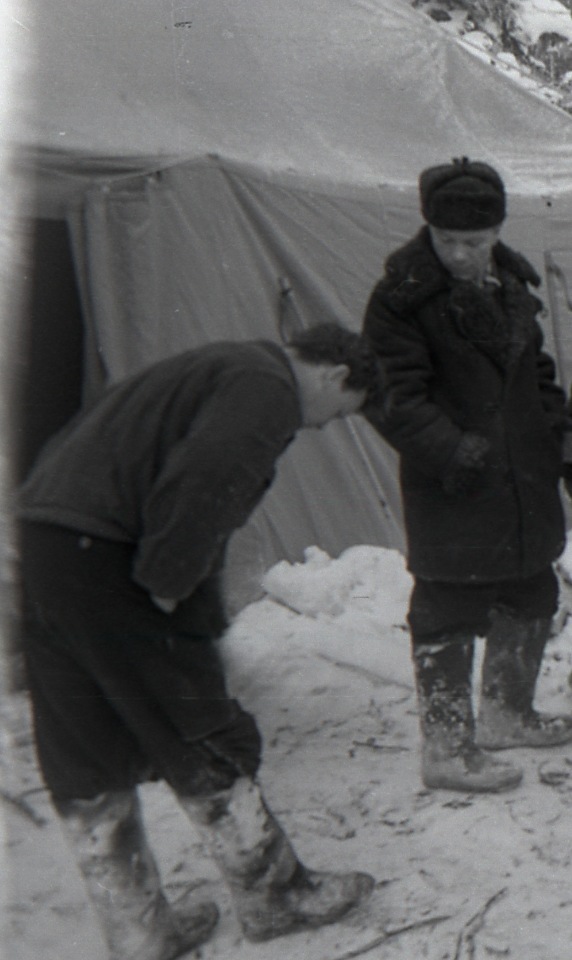
The entrance to the tent of the search party in their camp at Auspiya, which was there between late February and late April 1959, is itself visible behind the bend figure in front of Igor Nevolin (facing us) - I do not know what happened in the small building at the airfield, but it is possible that the same conditions have occurred there, purely theoretically.
- As for the possibility of obtaining such a picture in the morgue, to what I have already said above, one can add that it is almost impossible to get there a ray that will give the image of the diaphragm. Although, judging by the frame from there a number of conditions for obtaining it are available.
Now we must point out that it is unlikely that this photo was taken directly in Dyatlov tent during all events that occurred on February 1 or 2, 1959.
- In their tent there is no such space in which such a picture could be made. The tent was installed very low. The tent must have a height of no more than 130 ... 140 cm, which follows from the description when it was found on February 26, 1959 and the study on February 28, 1959. Ski poles had such a maximum height at that time. In addition, the entrance to the tent could not be rectangular, close to the square.
- In those weather conditions that have been identified by the two penultimate shots - cloudy weather, limited visibility, lack of sunshine, dusk - the amount of this is not enough conditions for it to be obtained.
Let's consider the reasons why the picture could be made by chance.
- There may be many reasons for accidental pressing of the camera button in the above described conditions, it is impossible to list everything.
- But there is one natural instance of the shutter release. After the end of the film, it should be rolled back onto the cassette, before being removed, not "lighted", from the camera. To do this, first press the "release" button, then move to the rewind position a special lever and rewind with a special pen. In older devices, such as Dyatlov group camera «Zorki», when reinstalling the rewind lever, without this rewind the film it was impossible. If the bolt was cocked, but the button was not pressed, then it automatically descended. What kind of excerpt is this ...? And who knows ..? Most likely, it was installed before that.
I suspect that many connoisseurs of photography who can prove with all the calculations and calculations, as well as trumpeting their own authority, will argue that this is not usually done, especially by professionals. Justification is simple: so, they say, the constantly cocked shutter stretches the spring of the timekeeping mechanism. I can say with the same certainty that in all the treks, especially the winter ones, I have never done this. Because the risk of losing an interesting shot was much more important than losing a few frames of the spent film. By the way, so did many experienced hikers who were engaged in photography in treks at a fairly high level: A. Makletsov, A. Kolesnikov, B. Ogorodnikov, V. Shimanovskiy are only those hikers-skiers, MSU of the USSR, with whom I discussed questions photography in the ski hikes.
In fact, everything could be and even easier. Someone from the search engines or investigators decided to just check whether the camera (camera mechanism) is in working order or not. He opened the case, cocked the bolt and pressed the trigger. Or, someone from them just pressed "descent", that would rewind the tape back on the tape.
And these, mentioned randomnesses can be one more proof of that in this case it is a usual technical or unsuccessful random shot, which does not carry any meaning and/or mystery.

